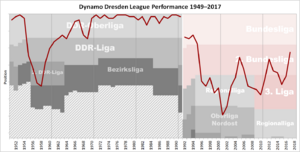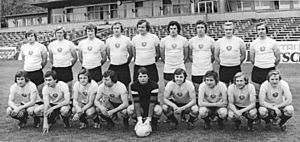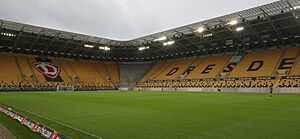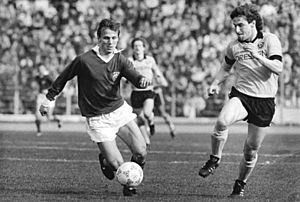Dynamo Dresden facts for kids
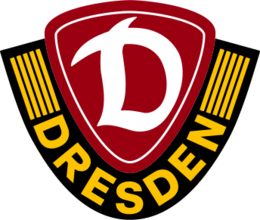 |
||||
| Full name | Sportgemeinschaft Dynamo Dresden e. V. | |||
|---|---|---|---|---|
| Nickname(s) | SGD, Dynamo | |||
| Founded | 12 April 1953 | |||
| Ground | Rudolf-Harbig-Stadion | |||
| Capacity | 32,085 | |||
| President | Holger Scholze | |||
| Sporting director | Ralf Becker | |||
| Head coach | Thomas Stamm | |||
| League | 2. Bundesliga | |||
| 2020–21 | 3. Liga, 1st of 20 (promoted) | |||
|
||||
Sportgemeinschaft Dynamo Dresden e.V., usually called SG Dynamo Dresden or Dynamo Dresden, is a German association football club. It is based in Dresden, Saxony. The club started on April 12, 1953. It was connected to the East German police. Dynamo Dresden became one of the most popular and successful clubs in East German football. They won eight league titles.
After German reunification, Dynamo played four seasons in the top league, Bundesliga, from 1991 to 1995. Since then, they have played in the second, third, and fourth divisions. The club competed in the 3. Liga, which is the third division of German football. They were promoted in the 2024-25 season and now play in the 2. Bundesliga.
The club's traditional uniform colors are gold and black. These colors come from the official city flag and the coat of arms of Dresden.
Contents
History of Dynamo Dresden
Starting Years (1950–1954)
The city of Dresden was important in German football before and during World War II. A local team, Dresdner SC, won national championships in 1943 and 1944. After the war, the Allied authorities who occupied Germany closed down many groups, including sports clubs like Dresdner SC. This was part of a process to remove Nazi ideas. Dresdner SC was restarted in 1946 as SG Friedrichstadt. However, the eastern part of Germany, including Dresden, was controlled by the Soviet Union. The authorities there thought the sports club was too old-fashioned.
On April 16, 1950, SG Friedrichstadt played ZSG Horst Zwickau in Dresden. This match would decide who won the East German championship in the 1949–50 season. About 60,000 people watched the game. Walter Ulbricht, a top leader of the ruling party, was also there. ZSG Horch Zwickau had started just one year before. It represented the kind of sports group the leaders wanted to support. ZSG Horch Zwickau won the match 5–1 and became East German champions. The game was very rough, and there were some unfair referee decisions that helped ZSG Horch Zwickau. The players of SG Friedrichstadt left the field without shaking hands with their opponents. Many angry Dresden fans went onto the field. East German sports authorities used these events as a reason to close down SG Friedrichstadt. They planned to move its players to another team, BSG VVB Tabak Dresden.
Dresden needed a new team that fit the government's ideas to play in the DDR-Oberliga. BSG VVB Tabak Dresden was supposed to take SG Friedrichstadt's place. But most players from SG Friedrichstadt, including player-coach Helmut Schön, did not agree to move. They left Dresden to join clubs in West Germany. To keep a team from Dresden in the DDR-Oberliga, the spot was given to SV Deutsche Volkspolizei Dresden instead.
At that time, SV Deutsche Volkspolizei Dresden played in a lower league. So, they were able to join the DDR-Oberliga without having to win their way up through divisions. To help them stay in the DDR-Oberliga, players from all over the country were brought in to make the team stronger.
SV Deutsche Volkspolizei Dresden first started as SG Volkspolizei Dresden in 1948. On June 20, 1950, Kurt Fischer, the head of the police, ordered a new main sports group for all police sports teams in East Germany. This new group was called SV Deutsche Volkspolizei. SG Volkspolizei Dresden joined this new group and changed its name to SV Deutsche Volkspolizei Dresden. Fischer's order also said that the best football players from police teams should be gathered in SV Deutsche Volkspolizei Dresden.
In July 1950, the 40 best players from different police teams in East Germany met for training. Coaches Fritz Sack and Paul Döring chose 17 players from 11 different cities. These players were sent to Dresden to form the new team. SV Deutsche Volkspolizei Potsdam lost five of its best players, including Herbert Schoen and Günter Schröter. This made their team much weaker. SV Deutsche Volkspolizei Dresden quickly became a strong team in East German football. They won their first title in the 1951–52 FDGB-Pokal.
A new sports group, SV Dynamo, was created on March 27, 1953. SV Dynamo was formed from SV Deutsche Volkspolizei and the sports teams of the Stasi, which was the secret police. The head of SV Dynamo was Erich Mielke, who was also a deputy head of the Stasi. SV Deutsche Volkspolizei joined SV Dynamo and became Dynamo Dresden on April 12, 1953. This date is now the official founding date of Dynamo Dresden. Soon after, the club won its first league title.
However, this success led to a problem for the club. In November 1954, the Dynamo Dresden team was moved to Berlin. They were to play for a new sports club, SC Dynamo Berlin, in the DDR-Oberliga. The remaining players of Dynamo Dresden were left to rebuild in the second division, the DDR-Liga. They took over the spot, points, and goals from a closed club, SC DHFK Leipzig. It is believed that political reasons and pressure from Erich Mielke were the main reasons for moving Dynamo Dresden to Berlin. The move was meant to give the capital city a strong team that could compete with popular West Berlin clubs.
Rising Again (1954–1969)
Dynamo Dresden was left with a team of young and reserve players. By 1957, they had dropped to the fourth division, playing in the local Bezirksliga. But Dynamo Dresden started to climb back up the divisions. By 1962, they were back in the DDR-Oberliga. Their first season back ended in them being moved down a division, but they quickly returned. They also recovered well from another move down in 1968. They stayed in the Oberliga from 1969 until the league ended in 1991. This move down in 1968 happened after they finished fourth in 1967. This allowed Dynamo to play in European football for the first time. They entered the 1967–68 Fairs Cup, where Rangers from Scotland beat them in the first round.
East German football was changed during the 1965–66 season. Ten football sections were separated from their sports clubs to create ten special football clubs (FC). The goal was to gather the best players in the country in these new clubs. This would make the top level of the game more stable and help develop players for the national team. There had been plans to combine Dynamo Dresden with the football section of SC Einheit Dresden. This would bring the best players in the region into one club, as had been done in Leipzig. However, a disagreement started between Erich Mielke and Werner Krolikowski, a top leader in the Dresden region. Erich Mielke did not want to give up Dynamo Dresden. Krolikowski wanted a civilian football club. This disagreement lasted for a year and a half. The football section of SC Einheit Dresden became FSV Lokomotive Dresden on January 12, 1966. Then, on August 5, 1968, Dynamo Dresden was named a regional center for top performance in the Dresden area. This meant the club could now get the best players from the entire region.
Dynamo Dresden received the same funding and benefits as the special football clubs. Even though it remained a "Sports Community" (SG), this support was very important for the club's future success.
Golden Years (1969–1978)
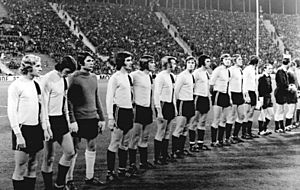
In the 1970s, Dynamo became one of the best teams in East Germany. This was under the coach Walter Fritzsch. They won five league titles (1971, 1973, 1976, 1977, and 1978). They also won two cups (1971 and 1977). They often competed with 1. FC Magdeburg for the top spot in the league. Dynamo became the most popular team in the country, regularly attracting about 25,000 fans. This was about three times more than other clubs. They also started to make a name for themselves in European football. They played in European competitions every year during the 1970s. They beat some big teams like FC Porto, Juventus, and Benfica. They reached the quarter-finals four times. During this time, Dynamo played against teams from West Germany for the first time. They lost to Bayern Munich 7–6 on total score in the last 16 of the 1973–74 European Cup. Dynamo Dresden lost the first game 4–3 away in Munich. They managed a 3–3 draw at home in the Dynamo-Stadion. The secret police had listened in on Bayern Munich's final team meeting before the second game. Information about Bayern Munich's lineup was quickly sent to Dynamo Dresden's coach, Walter Fritzsch. Three times, Liverpool from England eliminated them. Each time, Liverpool went on to win the competition. On three other occasions in the 1970s, Dynamo was eliminated by the team that eventually won the tournament.
In 1973, Hans-Jürgen Kreische was the first Dynamo Dresden player to be named East German Footballer of the Year. Hans-Jürgen Dörner followed him in 1977. Kreische was the league's top goalscorer four times. He was also part of East Germany's team for the 1974 World Cup, along with his teammate Siegmar Wätzlich.
Capital City's Influence (1978–1991)
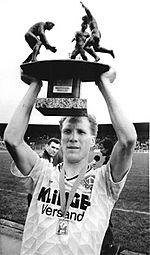
BFC Dynamo was a special club within SV Dynamo. It was located in Berlin, the capital of East Germany, which was a key city during the Cold War. This meant the club had to be very well-supported. BFC Dynamo was seen as the favorite club of Erich Mielke, the head of SV Dynamo and the secret police. With Mielke's support, BFC Dynamo got the best training facilities, equipment, coaches, and players.
East German football generally favored the special football clubs (FCs). These clubs had access to talented players from specific areas. Dynamo Dresden was a top center in the Dresden region, so it had special access to players there. However, BFC Dynamo could get players from all over East Germany, except the Dresden region. The club had the best resources in the league and a very strong team. BFC Dynamo won ten league titles in a row, from 1979 to 1988. Dynamo Dresden was most affected by their success, finishing second six times.
However, Dynamo Dresden also had its own supporters. According to Hans-Jürgen Dörner, three local politicians helped the club stay at the top. One was Hans Modrow, a long-time leader in the Dresden region. Another was Manfred Scheler, the head of the District Council in Dresden. Scheler was a dedicated fan who used his connections to help players get things that were hard to find, like a car or an apartment. A third supporter was Lieutenant General Willi Nyffenegger, the long-time head of the police in the Dresden region. The club also got support from Horst Böhm, a high-ranking officer in the secret police in Dresden. Böhm was involved in hiring and firing coaches and player contracts. He also supported the club financially. According to Hans-Jürgen Dörner, Horst Böhm put local pride first in the rivalry with BFC Dynamo. The rivalry between fans of the two Dynamo clubs even spread to different units within the secret police. Another strong supporter was Lothar Stammnitz, a long-time second-in-command in the Dresden region.
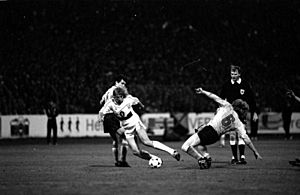
Walter Fritzsch retired in 1978. Gerhard Prautzsch took over, followed by former players Klaus Sammer (1983–86), Eduard Geyer (1986–90), and Reinhard Häfner (1990–91). The top players of the 1970s were replaced by a new group, including Torsten Gütschow, Ulf Kirsten, Matthias Sammer, and Andreas Trautmann. However, the club lost three important players in 1981: Gerd Weber, Peter Kotte, and Matthias Müller. They had been offered a good contract with a West German club and planned to leave East Germany during a national team trip. The secret police found out about this plan. In January 1981, the three players were stopped at the airport and banned from playing in the DDR-Oberliga for life. Weber was sentenced to two years in prison. Kotte and Müller, who had decided to stay in Dresden, were still punished for knowing about Weber's plans. Former Dresden leader Hans Modrow believed the actions against the three were "probably careful overall," considering how much worse things could have been for other East German citizens in similar situations. After all, the three were also part of the armed forces. Weber's helpers from Dresden received even harsher punishments. Dynamo Dresden won the FDGB-Pokal three times (1982, 1984, and 1985).
In the 1980s, the club continued to play in European football regularly. In the 1985–86 Cup Winners' Cup, they lost to Bayer Uerdingen from West Germany in a surprising way. They had won the first game 2–0 and were leading 3–1 at halftime in the second game. But their goalkeeper Bernd Jakubowski was injured. A new goalkeeper, Jens Ramme, came in and let in six goals. The team lost 7–3. Also, during this match, striker Frank Lippmann used the opportunity to leave for West Germany. Dynamo had their best European performance in the 1988–89 UEFA Cup. They beat AS Roma before losing to VfB Stuttgart in the semi-finals. Their last European season was the 1990–91 European Cup. It ended in a loss to the eventual winners, Red Star Belgrade. Dynamo's fans caused trouble at the second game, which led to the club being banned from European competitions for the next season.
The head of the police in Dresden was also the head of the SV Dynamo branch in Dresden. The police force officially sponsored Dynamo Dresden. Dynamo Dresden players were formally employed by the police. Many players then did their military service with the secret police's guard regiment and became formal employees of the secret police. 18 of the 72 players who played for Dynamo Dresden between 1972 and 1989 were listed as unofficial helpers for the secret police.
West German chancellor Helmut Kohl privately attended the match between Dynamo Dresden and FC Carl Zeiss Jena on May 28, 1988. This was during a private trip to East Germany. Dynamo Dresden ended BFC Dynamo's ten-year winning streak. They won the league title in the 1988–89 season. They celebrated the title after a 5–0 win against 1. FC Union Berlin in front of 27,000 fans at the Dynamo-Stadion on June 3, 1989. Dynamo Dresden also won the league title in the 1989–90 season. They also won a cup, completing a double. The Berlin Wall opened on November 9, 1989. The secret police then lost their influence over football during the season. BFC Dynamo was in fourth place after the first half of the season and finished the 1989–90 season in fourth place. With the fall of the Berlin Wall, many of the best players in East Germany moved to West Germany. BFC Dynamo was the first team to lose a top player. They lost their main striker Andreas Thom during the winter break. They lost more top players during the summer. Dynamo Dresden lost two key players in the summer of 1990: Ulf Kirsten and Matthias Sammer joined Bayer Leverkusen and VfB Stuttgart respectively. As German reunification was approaching, many clubs in the East changed their names to remove their Soviet connections. Dynamo Dresden changed from SG to the more traditional 1. FC. The DDR-Oberliga also changed its name for its final season to the NOFV-Oberliga. This league decided which spots East German clubs would get in the unified German league. Dynamo Dresden finished second, behind Hansa Rostock, which meant they qualified for the Bundesliga.
Bundesliga Years (1991–1995)

Dynamo had been a top club in East Germany, but playing in the Bundesliga was much harder. They faced financial difficulties and struggled on the field. They spent four years in this league, constantly fighting to avoid being moved down. Their best finish was 13th in 1993–94. But the next year, they finished in last place and were moved down. They had three different managers that season (Sigfried Held, Horst Hrubesch, and Ralf Minge). On top of this, the club owed more than 10 million DM. They were not allowed to play in the 2. Bundesliga and had to drop to the third division, Regionalliga Nordost. Rolf-Jürgen Otto, the club's president, was sent to prison for taking about 3 million DM from the club.
While many of the top players from the 1980s had moved west, some stayed for Dynamo's time in the Bundesliga. These included Torsten Gütschow and Hans-Uwe Pilz. The club also attracted players from other Eastern clubs, such as Olaf Marschall, René Müller, and Heiko Scholz. The fall of the Berlin Wall brought Dynamo its first foreign players. The club had international players from Australia (Mark Schwarzer), Poland (Piotr Nowak), Russia (Stanislav Cherchesov), and Sweden (Johnny Ekström), among others.
Ups and Downs (1995–2006)
Dynamo tried to rebuild in the Regionalliga. They again looked to former players to manage the team, including Hans-Jürgen Kreische (1995–96), Udo Schmuck (1996), and Hartmut Schade (1996–1998). However, they did not seriously challenge for promotion. In 1998, they finished second, but were 32 points behind the champions, Tennis Borussia Berlin. The 1999–2000 season saw changes to the Regionalliga. The four leagues were to be reduced to two. Dynamo needed to finish in the top 7 to avoid being moved down. They had finished 11th the season before. They hired Colin Bell, an English coach who had some success with youth football in Germany. But he left in March 2000 after poor results and a player rebellion. Cor Pot, a Dutchman, was brought in to replace him. He improved the team, but it was too late. They finished eighth and were moved down to the fourth-tier Oberliga Nordost-Süd. By this time, Dynamo was not even the top team in Dresden. Dresdner SC had returned after reunification and finished second in the Regionalliga Nordost in 2000.
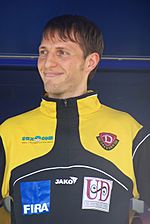
There was hope after how the last season ended, and the slogan "Wir kommen wieder" (we're coming back) was used. However, the Oberliga was now very competitive. VfB Leipzig, 1. FC Magdeburg, and FSV Zwickau had also been moved down. Dynamo could not match the consistent performance of their main rivals, Magdeburg and Leipzig. A 2–1 loss against Magdeburg in February ended their chances for promotion, and Pot resigned. With nothing left to play for, Dynamo finished fifth. For the next season, Christoph Franke became manager. He led the club to promotion. They won the league with only two losses. They beat Hertha BSC's reserve team in a playoff to earn their spot in the Regionalliga Nord. Dynamo's youth system was very successful during this time. Players like Lars Jungnickel, Silvio Schröter, Maik Wagefeld, and Daniel Ziebig went on to play at higher levels.
Dynamo finished 7th in their first season back in the third division. They then had another promotion in the following season, finishing second behind Rot-Weiß Essen. Life in the 2. Bundesliga started well, with a 3–1 win against MSV Duisburg. But by the middle of their first season, they were facing being moved down, with only 18 points. They recovered strongly in the second half of the season and finished 8th. This was partly thanks to new players like Ansgar Brinkmann, Joshua Kennedy, and Klemen Lavric. The 2005–06 season started similarly. Dynamo climbed to third place with a 2–1 win over 1860 Munich in the Allianz Arena. But this was followed by thirteen games without a win, leading to Christoph Franke being fired. Austrian manager Peter Pacult was brought in, and results improved for a while. But Dynamo still could not avoid being moved down, finishing 15th.
Building Stability (2006–Present)
Dynamo was back in the Regionalliga with the goal of immediate promotion. However, despite a good start, Peter Pacult left the club after six games to manage his former club, Rapid Vienna. Norbert Meier replaced him, but Dynamo could not keep up their promotion effort and finished seventh, partly due to poor performance away from home. Another change to the league structure was coming. Dynamo knew they needed to finish in the top 10 to qualify for the new national 3. Liga. Several former key players returned, including Lars Jungnickel, Marek Penksa, and Maik Wagefeld. But results were not consistent, and Meier was fired. Former coach Eduard Geyer replaced him. Dynamo secured qualification on the last day, finishing eighth. But Geyer was dismissed due to disagreements with the board. In 2007, the club went back to its original name, SG Dynamo Dresden.
The club hired Ruud Kaiser, a Dutchman known for his work with youth teams, as Geyer's replacement. They played in the very first match of the 3. Liga, beating Rot-Weiß Erfurt 1–0 with a goal from Halil Savran. But results were not consistent, and they only finished in the middle of the table. The 2009–10 season started poorly. With Dynamo in danger of being moved down, Kaiser was fired. Matthias Maucksch, a former player who had success with the reserve team, replaced him. Maucksch helped the team move away from the relegation zone and finished the season in 12th place. Maucksch led the team to compete for a playoff spot during the 2010–11 season. But he was fired in April after five games without a win. Ralf Loose replaced him. Loose finished the season without a loss and secured third place. This led to a playoff against VfL Osnabrück, which Dynamo won 4–2 on total score to earn promotion to the 2. Bundesliga.
Dynamo Dresden played well in their first season back in the league. They stayed in the middle of the standings and were never in danger of being moved down. After a memorable 4–3 victory against Bayer Leverkusen in the first round of the 2011–12 DFB-Pokal season, Dynamo was not allowed to play in the 2012/2013 DFB-Pokal. This was because of fan behavior and the use of fireworks during their second-round match against Borussia Dortmund (0–2). The punishment was later changed to one game played without fans and one away game without their own fan support. The club sold "virtual tickets" to help with money loss, which led to what was called the first sold-out "ghost game" in history. The 2012–13 season started badly for Dynamo. Ralf Loose was fired in December 2012 after a 3–0 loss to VfL Bochum, with the team in 15th place. Peter Pacult returned to the club after more than six years to replace him. Dynamo's performance improved after Pacult arrived, but the team still finished 16th in the league. Because of this, Dynamo had to play in relegation play-offs again after just two seasons. They met VfL Osnabrück once more, but this time their roles were reversed. Dynamo won 2–1 on total score and stayed in the second division for the 2013–14 season. Pacult was fired in August 2013 after a poor start. Olaf Janßen replaced him. Jansen could not save the club from dropping to the 3. Liga after they lost 3–2 at home to Arminia Bielefeld, a team also fighting to stay up. This result put them in 17th place and cost Jansen his job. Dynamo had drawn half of their matches, winning only five all season.
Under their new coach Stefan Böger, the club completely changed its team. Their goal was to return to the 2. Bundesliga as soon as possible. In August 2014, the team beat FC Schalke 04 2–1 in the first round of the DFB-Pokal. The team moved to the third round after beating VfL Bochum 2–1, but Borussia Dortmund eventually knocked them out. Böger was fired in February 2015. Assistant coach Peter Németh took over for the rest of the season. The team finished 6th in the 2014–15 season. Under new manager Uwe Neuhaus, Dynamo had a very successful season. They officially returned to the second division after a 2–2 draw in an away match against FC Magdeburg on April 16, 2016.
Club Structure and History
SV Dynamo and Club Identity
When Dynamo Dresden started as SG Volkspolizei, the club was supported by the East German police force. In 1953, when they became Dynamo Dresden, they were part of SV Dynamo. This was the sports organization for the security agencies. Dynamo was the most powerful of all the sports groups, which gave the club certain benefits. While many former security service clubs have struggled with their past image, especially BFC Dynamo, Dynamo Dresden remains popular and well-supported. The club has come to represent its home city.
Home Stadium
Dynamo plays at the Rudolf-Harbig-Stadion. It opened in 1923 and was also originally named after local athlete Rudolf Harbig. The East German authorities renamed the stadium Dynamo-Stadion in 1971. But it went back to its old name after reunification. The stadium originally held 24,000 spectators. It was rebuilt in the early 1990s to meet DFB and FIFA rules. It was fully modernized between June 2007 and December 2009. The new stadium opened on September 15, 2009, with a friendly game against Schalke 04. It can hold 32,066 spectators.
Supporters and Fan Culture
Dynamo was one of East Germany's most supported clubs. During their most successful time, they regularly had about 25,000 fans at games. Since reunification, attendance has changed with the team's performance. They were still one of the most supported teams in the lower leagues, with an average of 10,000–15,000 fans in the 3. Liga. After their promotion in 2011 to the 2nd League, they again drew crowds of 25,000. The average attendance for the 2013–14 season reached 27,004. Dynamo's supporters have very close ties with FK Sarajevo fans, known as Horde zla. In December 2020, Dynamo fans bought 72,000 tickets for a cup match at home against Darmstadt. This was even though the game was played in an empty stadium, showing support for the club during a difficult time.
Club Rivalries
Dynamo Dresden has a difficult relationship with BFC Dynamo. BFC Dynamo took over the first team and the spot in the DDR-Oberliga from Dynamo Dresden in 1954. BFC Dynamo was their main rival for success in the 1980s. However, the two clubs rarely play each other now. 1. FC Lokomotive Leipzig was traditionally Dynamo's main rival for dominance in Saxony. This rivalry also includes other clubs like Chemnitzer FC, Erzgebirge Aue, and more recently, RB Leipzig. Although these clubs have very different financial situations and have not played in the same division often, their only official match so far was a first-round game in the 2016–17 DFB-Pokal season, which Dresden won.
Dynamo's most notable rival in their home city is Dresdner SC. However, they are usually in different leagues, with Dresdner SC playing in local football leagues. Another club, SC Borea Dresden, was formed from SG Dynamo Dresden-Heide, which used to be a training club for Dynamo. But there is no longer an official connection between them.
Team Colors and Logo
When the club was formed as SG Volkspolizei Dresden, they wore green and white. These were the colors of the former province of Saxony and also the colors of the Volkspolizei. When the team became part of SV Dynamo, they started using the sports group's wine red color scheme. In 1968, the club was named a regional center for top performance in the Dresden area. They then adopted their current colors of yellow and black, which are the city colors of Dresden.
The club's first logo was based on the shield of the Volkspolizei, because they were connected to them. In 1953, they adopted the D logo of SV Dynamo. This logo stayed until German reunification. At that time, its wine red background was changed to Saxon green. They went back to the red background in the early 2000s.
Players
Current Squad
|
|
Players on Loan
|
|
Dynamo Dresden II (Reserve Team)
The club's reserve team, Dynamo Dresden II, played in the fifth-tier NOFV-Oberliga Süd until 2015. They had been at this level since 2009, with their best result being fourth place in 2012. In March 2015, the club announced they would remove the reserve team from league play. Instead, they would join a friendly competition with the reserve teams of Chemnitzer FC, Hallescher FC, Sparta Prague, FC Slovan Liberec, and FK Teplice. This competition, called the Future League, was meant to be more organized. However, it has mostly resulted in a series of friendly matches between amateur teams. The idea seems to have been largely given up by the clubs involved, despite some earlier plans.
The team also played in the 1995 Saxony Cup final, where they lost. They won the competition in 2009.
Club Staff
| Position | Name |
|---|---|
| Head coach | |
| Assistant head coach | |
| Assistant coach | |
| Goalkeeping coach | |
| Conditioning coach & Athletic coach | |
| Match analyst | |
| Managing director | |
| Sports coordinator | |
| Advisor of management | |
| Scout | |
| Doctor | |
| Physiotherapist | |
| Medical Director | |
| Press officer | |
| Team manager | |
| Marketing staff | |
| Supporter Liaison Officer | |
| Head of Media and Communications | |
| Kit manager | |
| Stadium Announcer | |
| Academy manager |
Coaching History
Dynamo had its biggest successes under Walter Fritzsch. He led them to win the first division DDR-Oberliga title in 1971, 1973, 1976, 1977, and 1978. They also finished second four times. The team also won the East German Cup (FDGB Pokal) in 1971 and 1977.
- Fritz Sack 07/1950 – 9/1951
- Rolf Kukowitsch 09/1951 – 04/1952
- Paul Döring 04/1952 – 07/1953
- Janos Gyarmati 07/1953 – 04/1954
- Helmut Petzold 04/1954 – 11/1955
- Heinz Werner 01/1956 – 06/1956
- Rolf Kukowitsch 07/1956 – 12/1956
- Helmut Petzold 01/1957 – 05/1966
- Manfred Fuchs 06/1966 – 03/1968
- Kurt Kresse 03/1968 – 06/1969
- Walter Fritzsch 06/1969 – 06/1978
- Gerhard Prautzsch 06/1978 – 06/1983
- Klaus Sammer 07/1983 – 06/1986
- Eduard Geyer 07/1986 – 04/1990
- Reinhard Häfner 04/1990 – 06/1991
- Helmut Schulte 06/1991 – 05/1992
- Klaus Sammer 06/1992 – 04/1993
- Ralf Minge 04/1993 – 06/1993
- Sigfried Held 06/1993 – 11/1994
- Horst Hrubesch 11/1994 – 02/1995
- Ralf Minge 02/1995 – 06/1995
- Hans-Jürgen Kreische 06/1995 – 04/1996
- Udo Schmuck 04/1996 – 09/1996
- Hartmut Schade 09/1996 – 03/1998
- Werner Voigt 04/1998 – 12/1998
- Damian Halata 12/1998 – 02/1999
- Rolf Schafstall 02/1999 – 03/1999
- Colin Bell 04/1999 – 03/2000
- Cor Pot 03/2000 – 03/2001
- Meinhard Hemp 03/2001 – 06/2001
- Christoph Franke 07/2001 – 12/2005
- Peter Pacult 12/2005 – 09/2006
- Norbert Meier 09/2006 – 09/2007
- Eduard Geyer 09/2007 – 06/2008
- Ruud Kaiser 06/2008 – 10/2009
- Matthias Maucksch 10/2009 – 04/2011
- Ralf Loose 04/2011 – 12/2012
- Peter Pacult 01/2013 – 08/2013
- Olaf Janßen 09/2013 – 05/2014
- Stefan Böger 05/2014 – 02/2015
- Peter Németh 02/2015 – 06/2015
- Uwe Neuhaus 07/2015 – 08/2018
- Cristian Fiél 08/2018 – 09/2018
- Maik Walpurgis 09/2018 – 02/2019
- Cristian Fiél 02/2019 – 12/2019
- Markus Kauczinski 12/2019 – 04/2021
- Alexander Schmidt 04/2021 – 03/2022
- Guerino Capretti 03/2022 – 06/2022
- Markus Anfang 07/2022 –04/2024
- Heiko Scholz 04/2024 –
Famous Former Players
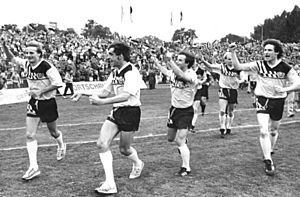
As one of the top clubs in East Germany, Dynamo Dresden had 36 players who played for the East German national team. This includes Hans-Jürgen Dörner, who played the second most games for the country, and Hans-Jürgen Kreische, who was tied for the second highest scorer. Twelve Dynamo players won Olympic medals, including six gold medalists in 1976. After German reunification, several Dynamo players went on to play for the German national team. These included Jens Jeremies, Ulf Kirsten, Olaf Marschall, and Alexander Zickler.
Five Dynamo Dresden players were named East German Footballer of the Year: Hans-Jürgen Dörner, Hans-Jürgen Kreische, Andreas Trautmann, Ulf Kirsten, and Torsten Gütschow. Dörner won the award three times. Kirsten, Trautmann, and Gütschow were the last three players to win it. Kreische and Gütschow were the top scorers in the DDR-Oberliga seven times between them.
Perhaps the most famous Dynamo Dresden player is Matthias Sammer. He played for the club from 1985 to 1990. During that time, he played 23 games for East Germany. He later played 51 games for Germany, winning the European Championship in 1996. At the club level, he played for VfB Stuttgart, Internazionale, and Borussia Dortmund. With Borussia Dortmund, he won two German titles, the UEFA Champions League, and the Intercontinental Cup. He was named European Footballer of the Year in 1996.
Club Achievements
National Titles
- DDR-Oberliga
- Champions: 1952–53, 1970–71, 1972–73, 1975–76, 1976–77, 1977–78, 1988–89, 1989–90
- Second Place: 1951–52, 1978–79, 1979–80, 1981–82 1983–84, 1984–85, 1986–87, 1990–91
- FDGB-Pokal
- Winners: 1952, 1970–71, 1976–77, 1981–82, 1983–84, 1984–85, 1989–90 (record, shared with 1. FC Magdeburg)
- Second Place: 1971–72, 1973–74, 1974–75, 1977–78
- DFV-Supercup
- Second Place: 1989
- Deutschland Cup
- Winners: 1990
- 3. Liga
- Champions: 2015–16, 2020–21
- Play-off Winners: 2010–11
Regional Titles
- Regionalliga Nord (III)
- Second Place: 2003–04 (promoted)
- NOFV-Oberliga (IV)
- Winners: 2002
- Sachsenliga (VI)
- Winners: 2009
- Saxony Cup (III–VI)
- Winners: 2003, 2007, 2009, 2024
Youth Titles
- Next Generation Oberliga (German: Nachwuchsoberliga) (de)
- Winners: 1979, 1983
- Second Place: 1977
- East German Junior Championship (de)
- Champions: 1962, 1972, 1981, 1982, 1985, 1988 (record)
- Second Place: 1975, 1983, 1984, 1987
- East German Youth Championship (de)
- Champions: 1983, 1988, 1989
- Second Place: 1982, 1990
- East German Junior Cup (Junge Welt-Pokal) (de)
- Winners: 1976, 1985, 1986, 1987 (record, shared with 1. FC Lokomotive Leipzig)
- East German Youth Cup (Youth FDGB-Pokal)
- Winners: 1973, 1989
- U17 NOFV Cup (de)
- Winners: 2003, 2017
- Second Place: 2006
Other Awards
- Indoor-Regio-Cup
- Winners: 2007
European Titles
- UEFA Cup
- Semi-finalists: 1988–89
- Intertoto Cup
- Co-winners: 1993
Doubles (League and Cup Wins)
- DDR-Oberliga and FDGB-Pokal
- Winners: 1970–71, 1976–77, 1989–90 (record)
European Competitions
| Season | Competition | Round | Nation | Club | Score |
|---|---|---|---|---|---|
| 1967–68 | Inter-Cities Fairs Cup | 1st round | Rangers | 1–1, 1–2 | |
| 1970–71 | Inter-Cities Fairs Cup | 1st round | Partizan | 0–0, 6–0 | |
| 2nd round | Leeds United | 0–1, 2–1 | |||
| 1971–72 | European Champion Clubs' Cup | 1st round | Ajax Amsterdam | 0–2, 0–0 | |
| 1972–73 | UEFA Cup | 1st round | VÖEST Linz | 2–0, 2–2 | |
| 2nd round | Ruch Chorzów | 1–0, 3–0 | |||
| Last 16 | FC Porto | 2–1, 1–0 | |||
| Quarter–finals | Liverpool | 0–2, 0–1 | |||
| 1973–74 | European Champion Clubs' Cup | 1st round | Juventus | 2–0, 2–3 | |
| Last 16 | Bayern Munich | 3–4, 3–3 | |||
| 1974–75 | UEFA Cup | 1st round | Randers Freja | 1–1, 0–0 | |
| 2nd round | Dynamo Moscow | 1–0, 0–1 (4–3 a.p.) | |||
| Last 16 | Hamburger SV | 1–4, 2–2 | |||
| 1975–76 | UEFA Cup | 1st round | ASA Târgu Mureș | 2–2, 4–1 | |
| 2nd round | Budapest Honvéd | 2–2, 3–0 | |||
| Last 16 | Torpedo Moscow | 3–0, 1–1 | |||
| Quarter–finals | Liverpool | 0–0, 1–2 | |||
| 1976–77 | European Champion Clubs' Cup | 1st round | Benfica | 2–0, 0–0 | |
| Last 16 | Ferencváros | 0–1, 4–0 | |||
| Quarter–finals | Zürich | 1–2, 3–2 | |||
| 1977–78 | European Champion Clubs' Cup | 1st round | Halmstads BK | 2–0, 1–2 | |
| Last 16 | Liverpool | 1–5, 2–1 | |||
| 1978–79 | European Champion Clubs' Cup | 1st round | Partizan | 0–2, 2–0 (5–4 a.p.) | |
| Last 16 | Bohemian | 0–0, 6–0 | |||
| Quarter–finals | Austria Wien | 1–3, 1–0 | |||
| 1979–80 | UEFA Cup | 1st round | Atlético Madrid | 2–1, 3–0 | |
| 2nd round | VfB Stuttgart | 1–1, 0–0 | |||
| 1980–81 | UEFA Cup | 1st round | Napredak Kruševac | 1–0, 1–0 | |
| 2nd round | Twente | 1–1, 0–0 | |||
| Last 16 | Standard Liège | 1–1, 1–4 | |||
| 1981–82 | UEFA Cup | 1st round | Zenit Leningrad | 2–1, 4–1 | |
| 2nd round | Feyenoord | 1–2, 1–1 | |||
| 1982–83 | UEFA Cup Winners' Cup | 1st round | B93 Kopenhagen | 3–2, 1–2 | |
| 1984–85 | UEFA Cup Winners' Cup | 1st round | Malmö FF | 0–2, 4–1 | |
| Last 16 | Metz | 3–1, 0–0 | |||
| Quarter–finals | Rapid Wien | 3–0, 0–5 | |||
| 1985–86 | UEFA Cup Winners' Cup | 1st round | Cercle Brugge | 2–3, 2–1 | |
| Last 16 | HJK Helsinki | 0–1, 7–2 | |||
| Quarter–finals | Bayer Uerdingen | 2–0, 3–7 | |||
| 1987–88 | UEFA Cup | 1st round | Spartak Moscow | 0–3, 1–0 | |
| 1988–89 | UEFA Cup | 1st round | Aberdeen | 0–0, 2–0 | |
| 2nd round | Waregem | 4–1, 1–2 | |||
| Last 16 | Roma | 2–0, 2–0 | |||
| Quarter–finals | Victoria Bucuresti | 1–1, 4–0 | |||
| Semi–finals | VfB Stuttgart | 0–1, 1–1 | |||
| 1989–90 | European Champion Clubs' Cup | 1st round | AEK Athens | 1–0, 3–5 | |
| 1990–91 | European Champion Clubs' Cup | 1st round | Union Luxembourg | 3–1, 3–0 | |
| Last 16 | Malmö FF | 1–1, 1–1 (5–4 a.p.) | |||
| Quarter–finals | Red Star Belgrade | 0–3, 0–3 (match abandoned) |
European Record Summary
| Competition | Record | ||||
|---|---|---|---|---|---|
| G | W | D | L | Win % | |
| European Cup | 30 | 12 | 6 | 12 | 40.00 |
| UEFA Cup | 48 | 21 | 17 | 10 | 43.75 |
| UEFA Cup Winners' Cup | 14 | 7 | 1 | 6 | 50.00 |
| Inter-Cities Fairs Cup | 6 | 2 | 2 | 2 | 33.33 |
| Total | 98 | 42 | 26 | 30 | 42.86 |
Images for kids
See also
 In Spanish: Dinamo Dresde para niños
In Spanish: Dinamo Dresde para niños


